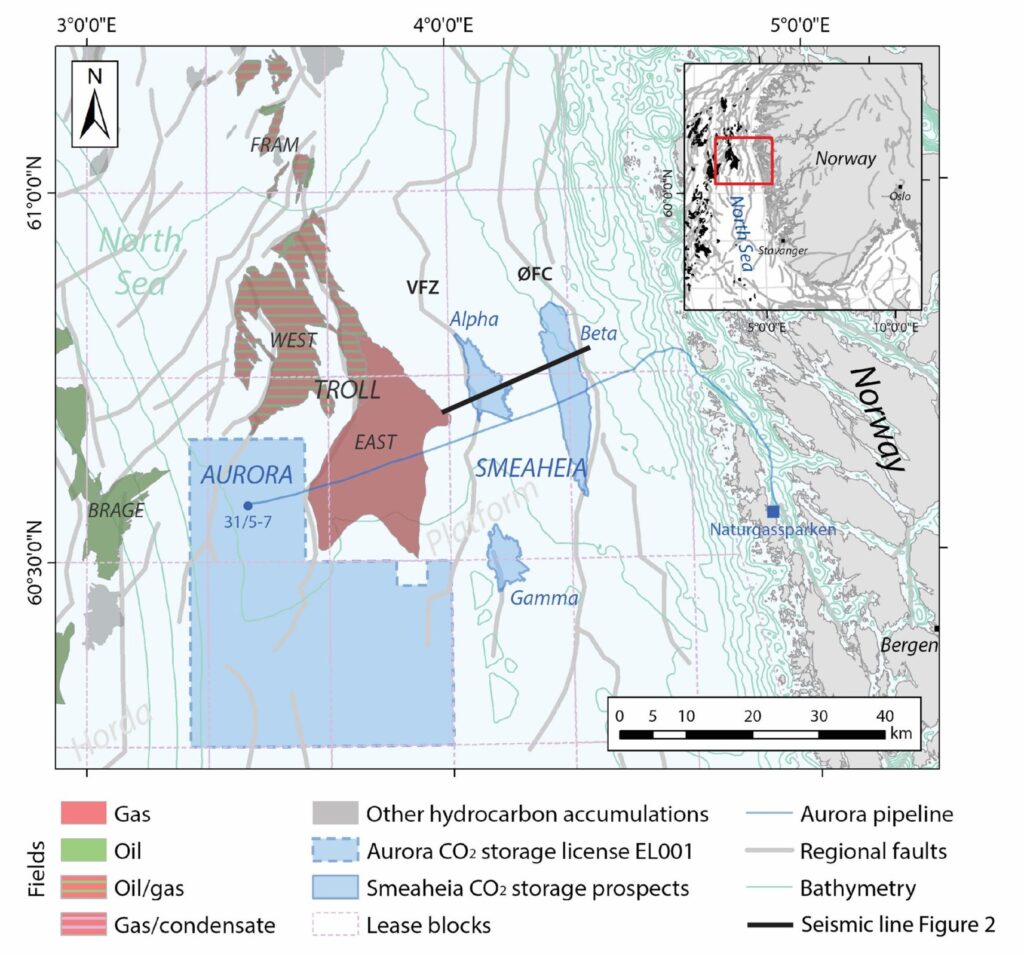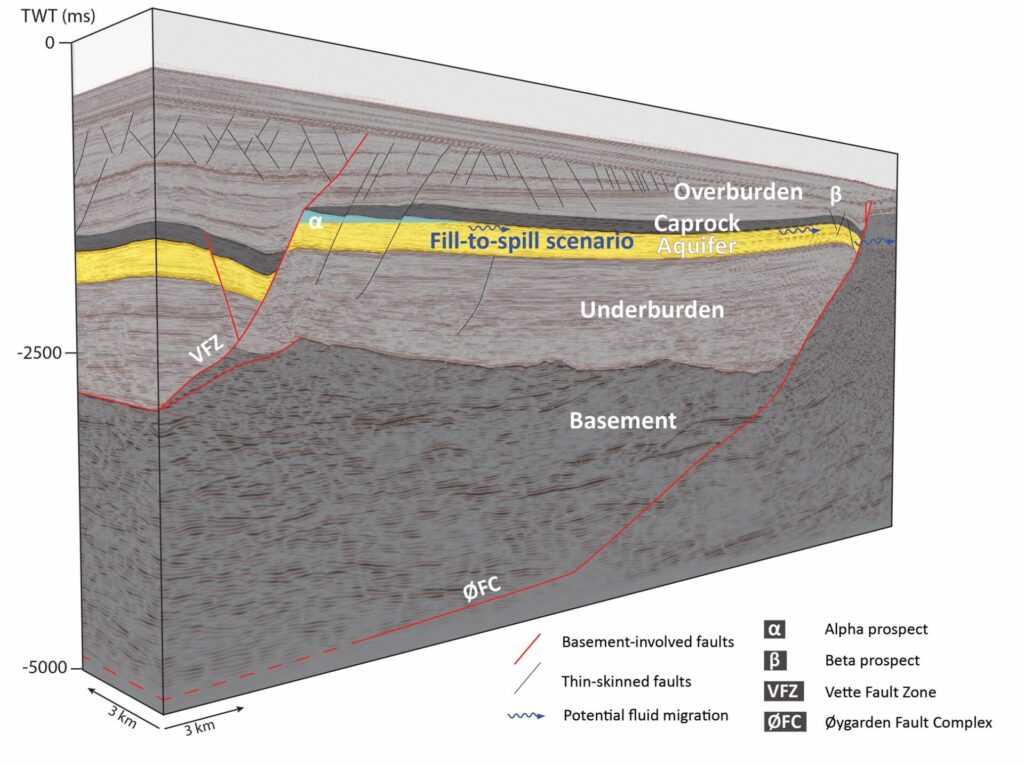
Researchers in the Norwegian CCS Research Centre (NCCS) have recently published a scientific article about the geological evolution of the Smeaheia fault block and key CO2 containment risks associated with the structural framework of the area. The findings provide key risk information for the flagship Northern Lights storage project and anyone working in the field of CCS and CO2 storage.
Reducing geological risk of CO2 storage
Structural derisking is a key research area within NCCS. Researchers are focused on identifying geological controls and associated risk related to CO2 storage in the northern North Sea. In addition, the task aims to optimize work flows that help qualify structural factors that may affect containment in fault bound aquifers which can be applied to global cases.
While the Northern Lights project is currently maturing the Aurora storage site(Figure 1) as the main subsurface target for full-chain Norwegian CCS, the Smeaheia fault block was previously considered the most promising CO2 storage site, and still offers potential storage expansion in the future.
Geological evolution of the Smeaheia fault block
Smeaheia is a north–south orientated fault block which forms the north-western part of the Horda Platform. The fault block is bound by two large fault systems, the Vette Fault Zone, and the Øygarden Fault Complex, both of which are thick-skinned meaning they extend down into crystalline basement rocks.
Learn more about CCS
Join our newsletter to stay updated with all the latest research results and news from NCCS: The Norwegian CCS Research Centre.
The fault block initiated due to rifting in the Permian-Triassic and underwent reactivation during an additional rift event in the Late Jurassic–Cretaceous during which a new population of northwest-southeast striking second-order faults developed. This second phase of rifting was concentrated in the Viking Graben area, but migrated eastwards over a 30 myr period.
As a result, rifting was most active in the Early Cretaceous in the Smeaheia fault block and continued into the Late Cretaceous. Minor reactivations in the Palaeocene–Eocene have also been recognized. A population of non-tectonic, low-displacement polygonal faults intersect the overburden and developed during the Eocene to middle Miocene. They are primarily strata-bound but are occasionally hard-linked with both first- and second-order tectonic faults.

The Smeaheia storage concept
The Smeaheia fault block contains three structural closures (Figure 1), i.e., stratigraphic or fault bound trapping structures in which CO2 can be injected. These closures were originally targeted as potential hydrocarbon accumulations but were all found to be water-bearing when drilled. In order for successful storage in the subsurface, a suitable aquifer is required. This is provided by the porous and permeable Jurassic aged Viking Group sandstones which were deposited in shallow marine environments. To facilitate trapping, a low permeability caprock, usually mudstone, is required. Upper Jurassic to Lower Cretaceous mud-dominated successions are proven caprocks in the Horda Platform.
Read more: The Safety of CO2 Storage
The original concept of storing CO2 in the Smeaheia fault block envisaged injecting CO2 into the Alpha structure which would fill to the point of spill, after which buoyant CO2 would migrate up dip along the aquifer-caprock interface and fill the Beta structure (Figure 2). The recently drilled Gamma structure (Figure 1), is much smaller than either Alpha or Beta, and would also spill over into the Beta structure if CO2 was injected.

Geological controls on CO2 containment
In order for CO2 to be trapped within the Alpha structure, it must not be able to flow across the bounding fault, in this case the Vette Fault Zone. Faults can be sealing if they contain low permeability lithologies across them, i.e., a juxtaposition seal, or if not, they must have significant volumes of low permeability material (shale gouge or clay smearing) incorporated along them during slip events, i.e., a membrane seal. In the case of the Alpha structure, the storage aquifer is juxtaposed against low permeability Cretaceous successions which are seen to act as a seal in the neighbouring Troll East field (Figure 1). Our mapping of the caprock shows that it thins significantly over the Alpha closure, however, a similar observation is made overlying the Troll East field where the Cretaceous successions again show capacity to seal.
We have also identified a population of vertically restricted (thin-skinned) faults that intersect the Alpha structure, some of which displace the storage aquifer, the caprock and the overburden. Cross-fault juxtaposition analysis shows that the storage aquifer is primarily self-juxtaposed, i.e., the porous and permeable Viking Group sandstone is not displaced past itself. This relationship could facilitate open fluid and pressure migration within the storage aquifer and these faults are unlikely to retard CO2 migration during and after injection.
These faults do, however, represent a potential risk to the integrity of the caprock. Fault reactivation is governed by the pore pressure regime, fault geometry, magnitude and directionality of in-situ stresses and mechanical properties of fault rock such as cohesion and internal angle of friction. Injection related pressure increase can pose a reactivation risk, which could in theory allow injected CO2 to flow up-section. Our provisional analysis, however, suggests that this risk is low, and more in-depth results will be published next year.
One key learning from this study is the fact that a large relay zone, i.e., a zone where two segments of the Vette Fault Zone overlap and transfer displacement, has been identified to the south of the Alpha structure. The target aquifer is again primarily self-juxtaposed across these faults and can facilitate pressure communication between Troll East and the Smeaheia fault block. As the Troll East field has been produced by depletion over the last 25+ years, the Smeaheia fault block is likely depleted. This depletion has consequences for storage capacity (can be reduced) and fault reactivation potential (may allow for higher injection pressures).
A notable risk associated with storage of CO2 in the Smeaheia fault block pertains to uncertainty of the fault sealing capacity of the Øygarden Fault Complex which bounds the Beta closure. This uncertainty relates to crystalline basement rocks in the footwall (up thrown side of the fault) of the Øygarden Fault Complex which are juxtaposed against the storage aquifer in the Beta structure. Fault seal algorithms were developed for siliciclastic systems, and cannot be readily modified for crystalline rocks.
Further, as the juxtaposed basement rocks in the footwall of the Øygarden Fault Complex are intensely fractured as well as weathered due to periods of exposure, their porosity and permeability are likely to be highly heterogeneous. The uncertainty associated the Øygarden Fault Complex requires greater scrutiny and is the focus of ongoing investigations.
Outlook for the Smeaheia fault block
While the primary focus for Norwegian full-chain CCS is now envisaged as the Aurora storage site, the closures in the Smeaheia fault block are adjacent to the proposed pipeline that will deliver CO2 to the Aurora injection site (Figure 1). As such, the Alpha prospect has the potential for being incorporated into the storage volume at a future date. Persistent uncertainties related to the fault seal capacity of the Beta structure, however, may warrant that the storage capacity of Alpha is significantly reduced to mitigate against a fill-to-spill scenario. The synthesis of our work, however, is optimistic for the suitability of the Alpha structure for CO2 storage. The Gamma structure is considerably smaller than Alpha, but offers further potential for future storage expansion. As such, the NCCS structural derisking team is now conducting detailed analysis of this structure.
More details of NCCS’s work on the Smeaheia fault block, can be seen in an article published in the November issue of the Journal of Marine and Petroleum Geoscience (Volume 121). The article is open access and can be accessed here.
Learn more about CCS
Join our newsletter to stay updated with all the latest research results and news from NCCS: The Norwegian CCS Research Centre.

0 comments on “Derisking the Smeaheia Fault Block: Geological Controls on CO2 Containment”